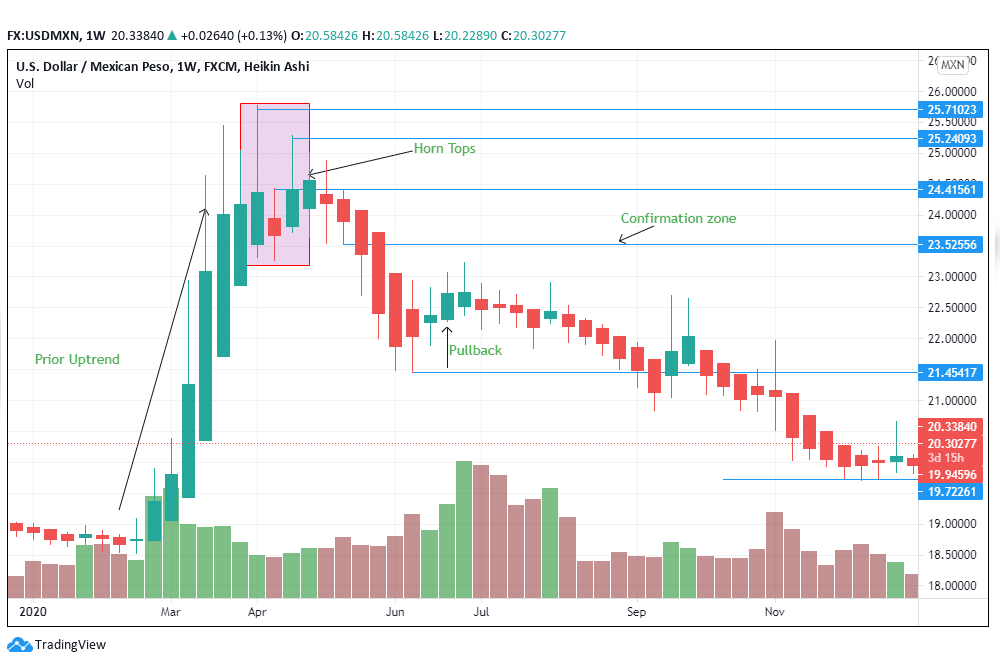Horn tops are upward spike formations that appear on weekly charts. They are used to predict short-term reversals and are separated by a week. Patterns with tall price formations and short spikes have better performance as compared to short ones with long spikes. A pattern may have a single or a double peak/ top depending on the stock’s price reversal point. The top is different from a horn bottom since the former is inverted and is found at the top of the weekly scale.
Identification guidelines
- Look for the high prior price
Prices rise to the formation of the horn top on the left side. There are normally twin peaks with a week’s separation mainly found close to the uptrend. The peaks are characterized by a high volume. The volume does not exceed the 25-day moving average by far.
Prices decline after forming the right peak so that it begins the bearish reversal. At times, it may take very little time for a pattern to have a sharp rise. On such occasions, the traders should expect a consolidation period that is followed by the bearish turn. Prices will drop and then initiate a pullback before continuing to drop. Short peaks will tend to have higher declines.
- Use the weekly chart
The trader will only spot the horn tops using the weekly chart. Two parallel spikes almost form the H-pattern. The spikes are formed at the top of the annual chart. It is confirmed when prices tend to close below (the lowest low/in the right spike) after 21 days.
The horn tops are highly visible as compared to other spikes within the year, as spotted in the weekly chart. In most cases, they are higher but with minimal price variation.

Figure 1: USD/MXN
In figure 1, the left horn top is formed from an uptrend in the weekly price chart. Prices rise from 18.5000 to 25.000 before it reaches the left horn top. Prices rise to 25.71023, the highest in the annual analysis. There is a slight decline in April 2020 as prices reach 24.41561 before they rise again to 25.24093 to complete the H-pattern.
After forming the right peak, prices drop to 21.45117 in June 2020 to complete the first phase of the bearish turn. There is a short pullback as prices rise to 23.23427 before the consolidation effect. The decline continues until it reaches 19.94596.
- Identify the confirmation point
The confirmation line for the USD/MXN trading pair 24.41561, which is below the lowest low of the horn top pattern. The lowest position of the pattern signals to the trader to initiate the sell option.

Figure 2: USD/MXN confirmation point
It has taken exactly three weeks for the chart pattern to shift from the bullish trend to a bearish reversal. The right peak formed on April 20, 2020, and the confirmation line was first witnessed on May 11, 2020. This period is sufficient to inform the trader that the horn-top is a true pattern thus establishing the fact the bearish trend will take shape.
After the long downtrend, the USD/MXN pair bounced up, as seen in the retracement period. Unlike other securities, the example used in this article has not moved to retest the lowest low position. It has instead continued to decline from May through to December 2020. The short retracement witnessed in the 3rd week of September 2020 did not after a pipe bottom.
The significance of the pipe bottom after a horn top is that it signals a trend change. Without viewing the pipe bottom, the trader is left with no option but to assume that the downtrend is likely to continue for at least two more months.
Pattern performance
- Reversal pattern
The horn top acts as a reversal as opposed to a bullish continuation. The prevailing price in the formation of the pattern is an uptrend. If the price continues to rise after the formation of the top, the pattern is disqualified from being a true horn top.
In a bear market, prices decline by up to 45% after the breakout. For example, in figure 2, the price drops from 24.41561 to 21.45417, representing a decline of more than 12% before the pullback. Ultimately, the price declines 18.31% as it closes the year at 19.94596. After the trader spots the horn top pattern, he should first initiate the sell signal and place a stop loss 15% below the sell position.
- Change after the ultimate low
Asset prices will change after hitting the ultimate low position, mostly at the end of the year. The change, as noted earlier, is first signaled by the pipe bottom or a rebound. In figure 2, the two retracements were too weak to force a rebound, and prices continued the bear trend. In case the trader notices that prices are soon to rebound, they should cover the stock. Avoid holding to the stock (in a sell position) if the signal for a rebound is given.
The price trend takes at least three weeks after the formation of the right spike to close below the lowest low in the horn top pattern. The length of this formation and the closure below the lowest position signals to the trader that the horn top is a true pattern. A look at figure 2, shows that there are 3 bars on the weekly chart from the third price peak to the breakout position. This conformation also gives way for a downward breakout.
Price breakouts happen mainly in the middle trading range after the horn tops are identified. The pattern will appear near the price peak before tumbling down.
Conclusion
The horn top pattern is an H-shaped formation that mainly occurs after an uptrend in prices, signaling a bearish reversal. Traders will initiate the sell signal after identifying the confirmation line. The downward breakout occurs after three weeks from the right spike of the horn top. Traders intending to use the pattern should adopt the weekly chart.
